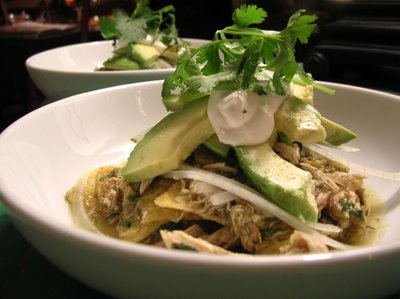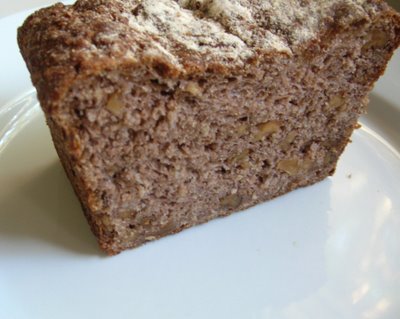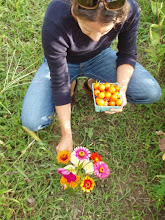
Yes, I've been known to sneak all the cherries out of the fruit bowl, and I've been caught more than once stealing extra frosting off the cake to put on my slice. I've even developed a reputation with my mother-in-law as that elicits warnings whenever one of her poundcakes and yours truly find themselves in the same room together... I will shamelessly cut just the crust off the poundcake, and leave that naked wobbly slice there in cold to fend for itself. I am guilty as charged of non-egalitarian eating. Forget the notion of building up to the climax, or saving the best for last, or even the idea that you don't deserve the frosting unless you eat the cake with it.
I'm not totally without dignity though. Ideally, a dessert or anything else for that matter, should be so good through and through that you don't want to give up a single crumb. It's a fine eating experience that finds you meticulously planning each bite so that you end with the ideal ratio of crust to the soft center, cake to frosting, or in this case, warm, gooey pears, and oh-so-tender gingerbread.
I have to admit there was nothing wrong with this cake, but last night, around 10:00 pm, eastern standard, you could find me hovering over the cake plate, slicing off the top half of a second piece of cake, just so I could eat the goopy pear topping, which had somehow transformed itself in the oven to a almost pudding-like texture. I threw the rest of the piece of the cake away, and never looked back.
I had read a few rave reviews of this cake in various places online, and when I recently bought Leslie Mackie's Macrina Bakery and Cafe Cookbook, it was one of the first recipes I tagged to try (after the Cracked Wheat Walnut Cider Loaf). I was torn between trying this recipe and a very similar recipe out of one of my favorite cookbooks, but ended up deciding on Leslie's recipe because of the copious amount of buttermilk called for - surely a sign of a tender and deliciously moist cake.
This cake was good, but admittedly, I don't think I'd make it again. Not to say that you might not love it, but although I loved how tender and moist the cake turned out, I expect something different from my gingerbread. I want it to be sticky, dark, and dense. I should also admit that skipping the fresh ginger might have made the cake less spectacular, so if you want to try this cake, definitely go for the bite of fresh ginger (mine was moldy, so I passed). I think a scoop of vanilla ice cream, or whipped cream would have been a wonderful accompaniment.
Ginger Pear Upside-Down Cake
Adapted Slightly from Leslie Mackie’s Macrina Bakery & Café Cookbook
The Pear Topping:
3 Tbs unsalted butter
½ cup light brown sugar
1 ½ tsp ground cinnamon
4-5 medium to large ripe (but not soft) pears, peeled, cored, and quartered lengthwise (I had to cut mine into eigths to make it work out)
The Gingerbread:
8 ounces (2 sticks) unsalted butter, at room temperature
¾ cup light brown sugar
2 Tbs peeled, grated ginger (I substituted 2 teaspoons ground ginger)
3 large eggs
2/3 cup molasses
3 cups unbleached all-purpose flour (I substituted a combination of spelt and whole wheat pastry flour)
1 ½ tsp baking powder
1 ½ tsp baking soda
½ tsp salt
1 ½ cups buttermilk, room temperature
Preheat the oven to 325 degrees Fahrenheit. Butter a 9-inch springform pan, and line the bottom with a 10-inch circle of parchment paper.
For the pear topping, combine 3 Tbs butter, ½ cup brown sugar, and cinnamon in a medium saucepan. Melt the butter over medium low heat until melted; then pour the mixture into the prepared springform pan, completely coating the parchment paper. Place the quartered pears on top of the butter-sugar mixture, lining the pieces up in a circle so that the entire bottom of the pan is covered.
For the gingerbread, cut 2 sticks of butter into 1-inch pieces, and put them in a large mixing bowl. Add ¾ cup brown sugar, and cream the mixture on medium speed for 3-5 minutes, until it is smooth and pale. Add the grated ginger (if using), and beat 1 minute more. Scrape down the sides of the bowl with a rubber spatula. Add the eggs one at a time, beating on low speed and making sure that each egg is fully incorporated before adding another. When all the eggs have been added, slowly pour in the molasses and beat to fully mix. The mixture might look as though it is curdling, but don’t worry—it will come together.
In a separate medium bowl, sift together the flour, baking powder, baking soda, (and ground ginger if using) and salt. Whisk to fully combine.
Alternately add small amounts of flour and buttermilk to the batter, stirring and folding with a rubber spatula until the dry ingredients are just absorbed. Do not overmix the batter. Pour and scrape the batter into the pear-lined pan, smoothing the top with a rubber surface. The pan will be nearly full.
Carefully transfer the pan to the center rack of the oven, and bake for about 1 hour and 45 minutes, until a skewer inserted in the cake’s center comes out clean. Let the cake cool in the pan for 10 minutes on a wire rack. Cover the pan with an upside-down serving plate; then carefully invert them together. Release the sides of the pan, and lift it away. Gently lift the pan’s base off the cake, and peel away the parchment paper. Allow the cake to cool for a half hour or so, and serve warm, with whipped cream.

Note from the Baker :
I had quite a lot of batter leftover, so I used some of my silicone canneles molds, and got 8 little mini gingerbreads out of it; not sure where all the extra batter came from, but the little cakes sure turned out cute!










